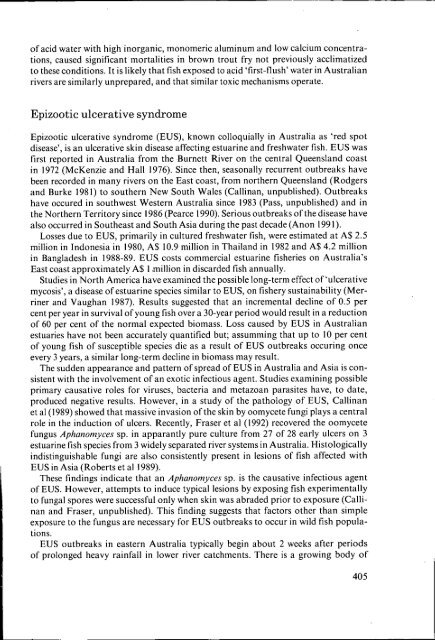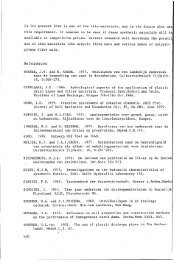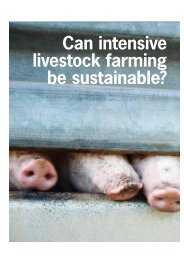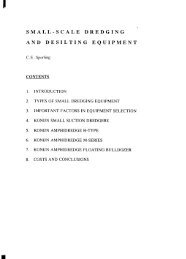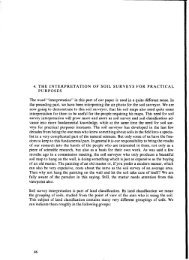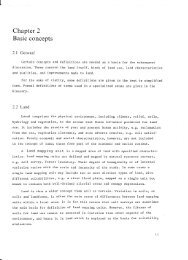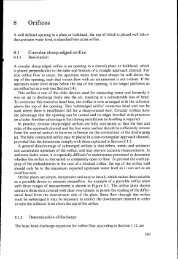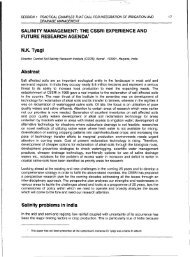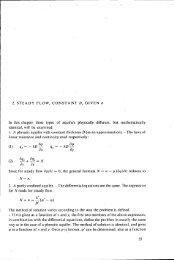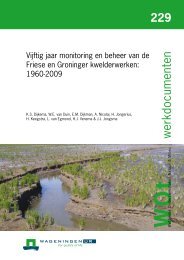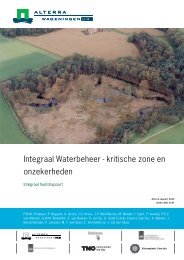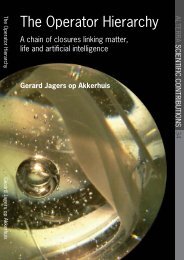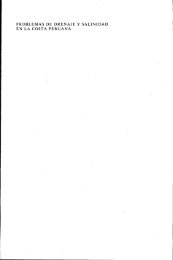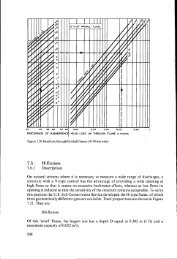Environmental aspects of acid sulphate soils - ROOT of content
Environmental aspects of acid sulphate soils - ROOT of content
Environmental aspects of acid sulphate soils - ROOT of content
Create successful ePaper yourself
Turn your PDF publications into a flip-book with our unique Google optimized e-Paper software.
<strong>of</strong> <strong>acid</strong> water with high inorganic, monomeric aluminum and low calcium concentrations,caused significant mortalities in brown trout fry not previously acclimatizedto these conditions. It is likely that fish exposed to <strong>acid</strong> ‘first-flush’ water in Australianrivers are similarly unprepared, and that similar toxic mechanisms operate.Epizootic ulcerative syndromeEpizootic ulcerative syndrome (EUS), known colloquially in Australia as ‘red spotdisease’, is an ulcerative skin disease affecting estuarine and freshwater fish. EUS wasfirst reported in Australia from the Burnett River on the central Queensland coastin 1972 (McKenzie and Hall 1976). Since then, seasonally recurrent outbreaks havebeen recorded in many rivers on the East coast, from northern Queensland (Rodgersand Burke 1981) to southern New South Wales (Callinan, unpublished). Outbreakshave occured in southwest Western Australia since 1983 (Pass, unpublished) and inthe Northern Territory since 1986 (Pearce 1990). Serious outbreaks <strong>of</strong> the disease havealso occurred in Southeast and South Asia during the past decade (Anon 199 I).Losses due to EUS, primarily in cultured freshwater fish, were estimated at A$2.5million in Indonesia in 1980, A$ 10.9 million in Thailand in 1982 and A$4.2 millionin Bangladesh in 1988-89. EUS costs commercial estuarine fisheries on Australia’sEast coast approximately A$ 1 .million in discarded fish annually.Studies in North America have examined the possible long-term effect <strong>of</strong> ‘ulcerativemycosis’, a disease <strong>of</strong> estuarine species similar to EUS, on fishery sustainability (Merrinerand Vaughan 1987). Results suggested that an incremental decline <strong>of</strong> 0.5 percent per year in survival <strong>of</strong> young fish over a 30-year period would result in a reduction<strong>of</strong> 60 per cent <strong>of</strong> the normal expected biomass. Loss caused by EUS in Australianestuaries have not been accurately quantified but; assumming that up to IO per cent<strong>of</strong> young fish <strong>of</strong> susceptible species die as a result <strong>of</strong> EUS outbreaks occuring onceevery 3 years, a similar long-term decline in biomass may result.The sudden appearance and pattern <strong>of</strong> spread <strong>of</strong> EUS in Australia and Asia is consistentwith the involvement <strong>of</strong> an exotic infectious agent. Studies examining possibleprimary causative roles for viruses, bacteria and metazoan parasites have, to date,produced negative results. However, in a study <strong>of</strong> the pathology <strong>of</strong> EUS, Callinanet al (1989) showed that massive invasion <strong>of</strong> the skin by oomycete fungi plays a centralrole in the induction <strong>of</strong> ulcers. Recently, Fraser et al (1992) recovered the oomycetefungus Aphanomyces sp. in apparantly pure culture from 27 <strong>of</strong> 28 early ulcers on 3estuarine fish species from 3 widely separated river systems in Australia. Histologicallyindistinguishable fungi are also consistently present in lesions <strong>of</strong> fish affected withEUS in Asia (Roberts et al 1989).These findings indicate that an Aphanomyces sp. is the causative infectious agent<strong>of</strong> EUS. However, attempts to induce typical lesions by exposing fish experimentallyto fungal spores were successful only when skin was abraded prior to exposure (Callinanand Fraser, unpublished). This finding suggests that factors other than simpleexposure to the fungus are necessary for EUS outbreaks to occur in wild fish populations.EUS outbreaks in eastern Australia typically begin about 2 weeks after periods<strong>of</strong> prolonged heavy rainfall in lower river catchments. There is a growing body <strong>of</strong>405


